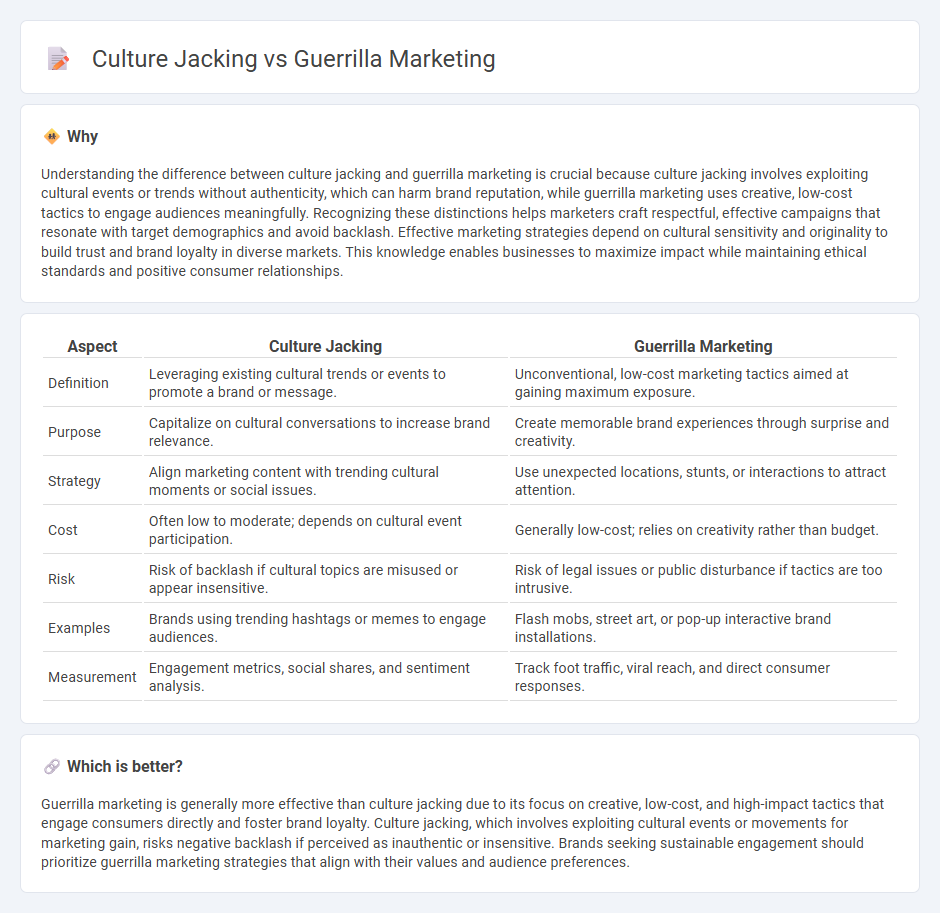
Culture jacking leverages current trends and social movements to insert a brand into relevant cultural conversations, often sparking viral engagement through timely and relatable content. Guerrilla marketing employs unconventional, low-cost tactics and creative public stunts to capture maximum attention and generate buzz in targeted environments. Explore how these innovative strategies can transform your marketing campaigns for greater impact.
Why it is important
Understanding the difference between culture jacking and guerrilla marketing is crucial because culture jacking involves exploiting cultural events or trends without authenticity, which can harm brand reputation, while guerrilla marketing uses creative, low-cost tactics to engage audiences meaningfully. Recognizing these distinctions helps marketers craft respectful, effective campaigns that resonate with target demographics and avoid backlash. Effective marketing strategies depend on cultural sensitivity and originality to build trust and brand loyalty in diverse markets. This knowledge enables businesses to maximize impact while maintaining ethical standards and positive consumer relationships.
Comparison Table
| Aspect | Culture Jacking | Guerrilla Marketing |
|---|---|---|
| Definition | Leveraging existing cultural trends or events to promote a brand or message. | Unconventional, low-cost marketing tactics aimed at gaining maximum exposure. |
| Purpose | Capitalize on cultural conversations to increase brand relevance. | Create memorable brand experiences through surprise and creativity. |
| Strategy | Align marketing content with trending cultural moments or social issues. | Use unexpected locations, stunts, or interactions to attract attention. |
| Cost | Often low to moderate; depends on cultural event participation. | Generally low-cost; relies on creativity rather than budget. |
| Risk | Risk of backlash if cultural topics are misused or appear insensitive. | Risk of legal issues or public disturbance if tactics are too intrusive. |
| Examples | Brands using trending hashtags or memes to engage audiences. | Flash mobs, street art, or pop-up interactive brand installations. |
| Measurement | Engagement metrics, social shares, and sentiment analysis. | Track foot traffic, viral reach, and direct consumer responses. |
Which is better?
Guerrilla marketing is generally more effective than culture jacking due to its focus on creative, low-cost, and high-impact tactics that engage consumers directly and foster brand loyalty. Culture jacking, which involves exploiting cultural events or movements for marketing gain, risks negative backlash if perceived as inauthentic or insensitive. Brands seeking sustainable engagement should prioritize guerrilla marketing strategies that align with their values and audience preferences.
Connection
Culture jacking leverages prevailing cultural trends to create impactful marketing messages, aligning closely with guerrilla marketing's emphasis on unconventional, attention-grabbing tactics. Both strategies focus on generating organic engagement by tapping into social conversations and cultural moments, enhancing brand visibility without relying on traditional advertising channels. This synergy enables marketers to craft authentic, memorable campaigns that resonate deeply with targeted audiences.
Key Terms
**Guerrilla Marketing:**
Guerrilla marketing leverages unconventional, low-cost tactics to create high-impact brand awareness, often using surprise and creativity in public spaces to engage target audiences directly. This strategy contrasts with culture jacking, which involves capitalizing on current cultural trends or movements to insert a brand message, sometimes controversially. Explore more about how guerrilla marketing can transform your brand's visibility with innovative campaigns.
Ambush
Ambush marketing exploits major events by covertly associating a brand with them without official sponsorship, while culture jacking involves tapping into cultural moments or trends to insert a brand message aggressively. Both guerrilla marketing techniques rely on surprise and creativity to capture audience attention, but ambush marketing specifically targets high-profile venues and audiences by piggybacking on established events. Discover how ambush marketing strategies can maximize brand exposure effectively in competitive spaces.
Unconventional
Guerrilla marketing employs unconventional tactics like ambushes, street art, or flash mobs to create memorable brand experiences that engage audiences through surprise and creativity. Culture jacking leverages current cultural events or trends by opportunistically inserting a brand's message into the cultural conversation, often provoking strong emotional responses. Explore the unique strategies and impactful examples of both guerrilla marketing and culture jacking to enhance your brand's unconventional outreach.
Source and External Links
Guerrilla Marketing - Wikipedia - This article defines guerrilla marketing as an unconventional advertising strategy that uses surprise and creative interactions to promote products or services.
What Is Guerrilla Marketing? - Coursera - This piece explains guerrilla marketing as a method that uses surprise and inventive displays to engage the target audience, particularly effective for generating publicity.
Guerrilla Marketing: Understand What It Is and How to Do It - Salesforce - This blog post discusses guerrilla marketing as an unconventional strategy that creatively attracts public attention, offering benefits like increased engagement and reach.
 dowidth.com
dowidth.com